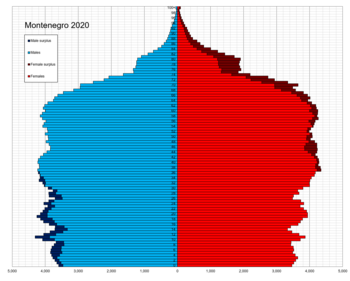
Back Monteneqro əhalisi Azerbaijani Черногория халҡы Bashkir Насельніцтва Чарнагорыі Byelorussian Население на Черна гора Bulgarian Obyvatelstvo Černé Hory Czech Δημογραφία του Μαυροβουνίου Greek Demografía de Montenegro Spanish Démographie du Monténégro French Demografía de Montenegro Galician Չեռնոգորիայի բնակչություն Armenian
| Demographics of Montenegro | |
|---|---|
 Population pyramid of Montenegro in 2020 | |
| Population | 604,966 (2022 est.) |
| Growth rate | -0.41% (2022 est.) |
| Birth rate | 11.19 births/1,000 population (2022 est.) |
| Death rate | 10.33 deaths/1,000 population (2022 est.) |
| Life expectancy | 77.75 years |
| • male | 75.32 years |
| • female | 80.27 years (2022 est.) |
| Fertility rate | 1.81 children born/woman (2022 est.) |
| Infant mortality rate | 3.24 deaths/1,000 live births |
| Net migration rate | -4.97 migrant(s)/1,000 population (2022 est.) |
| Age structure | |
| 0–14 years | 18.14% |
| 65 and over | 16.02% |
| Sex ratio | |
| Total | 0.97 male(s)/female (2022 est.) |
| At birth | 1.04 male(s)/female |
| Under 15 | 1.07 male(s)/female |
| 65 and over | 0.69 male(s)/female |
| Nationality | |
| Nationality | Montenegrin |
| Major ethnic | Montenegrin (45%) |
| Minor ethnic | Serbian (28.7%) |
| Language | |
| Official | Montenegrin (37%) |
| Spoken | Serbian (42.9%) |
| Year | Pop. | ±% p.a. |
|---|---|---|
| 1921 | 311,341 | — |
| 1931 | 360,044 | +1.46% |
| 1948 | 377,189 | +0.27% |
| 1953 | 419,873 | +2.17% |
| 1961 | 471,894 | +1.47% |
| 1971 | 529,604 | +1.16% |
| 1981 | 584,310 | +0.99% |
| 1991 | 615,035 | +0.51% |
| 2003 | 620,145 | +0.07% |
| 2011 | 620,029 | −0.00% |
| 2023 | 633,158 | +0.17% |
| Source:[1] [2] | ||
Demographic features of the population of Montenegro include population density, ethnicity, education level, health of the populace, economic status, religious affiliations and other aspects.
- ^ "Area, population and households according to censuses" (PDF). MONSTAT. Retrieved 13 February 2024.
- ^ "Preliminary results of the 2023 Census of Population, Households, and Dwellings" (PDF). MONSTAT. Retrieved 13 February 2024.
© MMXXIII Rich X Search. We shall prevail. All rights reserved. Rich X Search